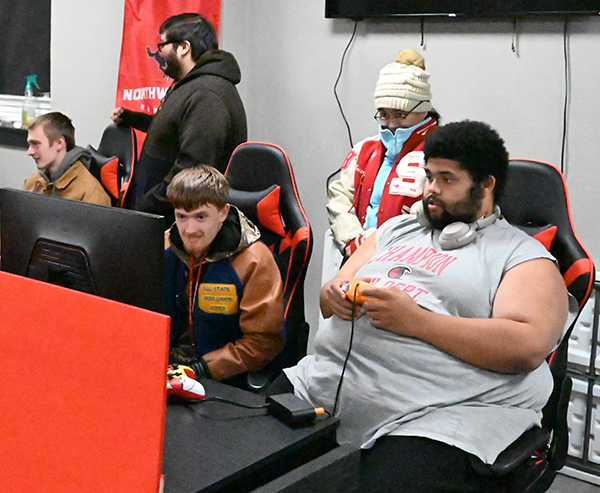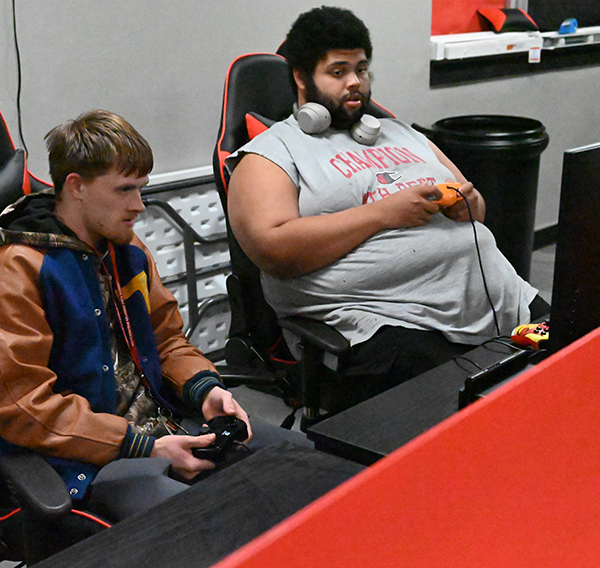Esports rising in popularity at Northwestern
By BENJAMIN KLIEWER, Senior Reporter

Students sit down at their computers and fire up their favorite video games. But they’re not just average players – they’re athletes-in-training.
Virtual sports tournaments, called esports tournaments, have grown in popularity around the nation, and Northwestern’s own program is growing.
Evan Vaverka, an instructor of computer science Northwestern, said the popularity of esports is growing, in part, because of its accessibility.
“From an outside viewer’s perspective, if you’re just a person who likes watching people compete, you can pick up an esport game pretty quickly because the games are pretty self-explanatory,” he said.
Computer science major John Cloud said video game manufacturers are becoming focused on making games with competitive tournaments in mind, driving up their popularity.
The livestreaming of video games on social media platforms has driven up viewership numbers, he added. Twitch, a popular site for podcasting, focused on video game streaming in its infancy.
EVOLUTION OF ESPORTS
Despite the concept’s relatively recent popularity on college campuses, the road to getting esports into the educational mainstream has been long. Researchers with the University of New Haven wrote that in 1972 five Stanford University students competed in the first video game competition. The tournament, in which students played the game “Spacewar,” was called the Intergalactic Spacewar Olympics. The winner received a year’s subscription to Rolling Stone magazine.
The first esports tournaments were based on high scores. The most notable tournaments were Atari’s 1980 “Space Invaders” Championship, which attracted more than 10,000 competitors. In 1991, “Street Fighter II” changed tournaments by relying on face-to-face competition instead of high scores.
The next step that increased public awareness was in 1997 when Quake hosted its Red Annihilation tournament. The winner of the tournament received game developer John Carmack’s 1987 Ferrari 328 GTS. Over 2,000 gamers competed in the one-on-one death matches with the final 16 competitors facing off in Atlanta, Georgia.
Representatives with tech dealer CDW wrote on the company’s website that The Quake’s “Red Annihilation” competition is commonly regarded as the first true esports event.
Both the Cyberathlete Professional League and the Professional Gamers League were formed in 1997. Five years later, the Major League Gaming came onto the scene.
Fast forward to 2021, and the League of Legends World Tournament peaked at 73,860,742 viewers, according to the LOL Esports Media Center.
Werner Geyser, a writer for the Influencer Marketing Hub, said the esports industry has seen a tremendous rise in popularity since 2015. Then, slightly more than 800,000 people had heard about it. But these numbers soon changed, and by the following year, more than a billion people had learned about esports.
“One of the main reasons there has been growth in eSports viewership is that more people are learning about it,” he wrote in an article for the company.
GETTING PAID TO PLAY
Financial support for esports professionals come from a few different sources. The biggest sources of support used to be viewers who donated or bought merchandise from their favorite teams. Now, a professional esports player who has earned popularity can find financial backing from sponsorships and contracts from esports teams.
Prize pools offer another way to earn money for professionals, though they’re not as consistent as sponsorships. Some prize pools are worth millions, according to USA Today. In 2021, the prize pool for the online game Dota 2 was was around $47.2 million.
For tournaments, host support comes from people purchasing the games or from the sale of in-game items such as battle passes. Also, some businesses find esports to be large enough venues to advertise in.
Northwestern’s esports players have a practice room in Shockley Hall, where they gather to train. Here, players have access to high-end computers that allow them to compete without any technical worries.
Some of the games the esports teams play include “Overwatch,” “Super Smash Brothers” and “Call of Duty.”
Northwestern’s esports players can also obtain scholarships for playing, similar to those for football and basketball players. This scholarship is available for 25 to 30 students, Vaverka told the Northwestern News in February.
PROFESSIONAL ATHLETES?
Tournaments are not restricted to the professional world level, and esports is developing levels of play much like football. High school tournaments are springing up across the country, and some institutions are recognizing them as official sports.
College-level esports can lead into the professional level if esports teams like what they see in a player, Vaverka said.
Northwestern is in a group called the Oklahoma Association of College Esports, which practices with and competes against other colleges from Oklahoma, Colorado and Arkansas.
Many esports gamers hope to ascend to the professional level, Cloud said, because the culture of gaming has changed. In the past, people considered video games to be a fun pastime. Now, he said, people want to be competitive – and be the best.
Northwestern News Senior Reporter Austin Morton contributed to this story.

